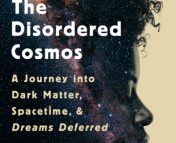This post is part of our series #BlackInAstro. For our cornerstone post, see here. This week, we will be posting a #BlackInAstro story every day for #BlackInAstroWeek.
On June 10, 2020, in response to a number of highly-visible murders of Black people in the U.S. and Canada, groups of physicists and astronomers called for a Strike for Black Lives and pledged to #ShutDownSTEM.
“We demand justice, reform, and accountability now,” reads the statement written by the Particles for Justice collective of physicists, who called for the Strike for Black Lives. “Therefore, as physicists, we believe an academic strike is urgently needed: to hit pause, to give Black academics a break and to give others an opportunity to reflect on their own complicity in anti-Black racism in academia and their local and global communities.”
Thousands of members of the scientific community participated in the grassroots event by canceling meetings and refusing to do research labor, and a number of physics and astronomy institutions followed suit. For one day, some scientific publications (including Nature, arXiv, and our own Astrobites) delayed publication. Many departments planned day-long workshops or discussion groups (see, e.g., this statement from MIT). Organizations—the American Astronomical Society, the American Physical Society, the American Association for the Advancement of Science (which publishes the journal Science), and the American Institute of Physics, to name a few—released statements in support of the strike.
But although the strike itself was meant to be a one-day pause to “business as usual,” the support for Black people in academia was not meant to end after one day. “June 10, 2020 will mark the day that we transition into a lifelong commitment of actions to eradicate anti-Black racism in academia and STEM,” the organizers of #ShutDownSTEM stated on their website.
So how has this commitment held up? One year after this vocal outpouring of support, what actions have the physics and astronomy communities followed through? What has worked to center Black lives and experiences, and what hasn’t? To answer these questions, Astrobites gathered updates from over 25 astronomy and physics institutions around the world.
In this first part of this two-part series, we’ll do an inventory of what these institutions have done. (We note that this piece is not an endorsement of any institution or its responses! We’re simply summarizing what some institutions have done.) In the second part, we’ll address the shortcomings of institutional responses, and how we can do better.
Starting conversations
A number of institutions used the Strike For Black Lives to start conversations about anti-racism and equity that are still ongoing—for example, hosting regular anti-racism reading or discussion groups. “During these discussions we talk about books or videos or podcasts or articles that seem pertinent,” explains Dr. Manisha Shrestha, a postdoc at Liverpool John Moores University. Some departments, including Princeton Physics/Astrophysics and McMaster University Physics & Astro, have started hosting colloquia on equity, diversity, and inclusion (EDI), which in some cases has led to concrete financial investment: Liverpool John Moores allocated funding for EDI speakers, and Princeton started a $30,000/year department fund to support speaker travel.
Another approach has been to bring in outside help. UCLA invited speakers to discuss concrete strategies such as hiring practices, and Northwestern’s CIERA went a step further, hiring Movement Consulting who “provide consulting services for socially conscious scientists who want to transform their workplace but don’t know where to start.” As PhD student Anya Nugent explains, they lead training sessions on supporting/mentoring people of various backgrounds and understanding systemic racism in astronomy departments.
The Ohio State University Astronomy Department is taking advantage of the resources produced by the AIP TEAM-UP program (check out our previous posts on TEAM-UP here and here): “We are working through the activities/steps to build the framework to better support Black students,” says Professor Laura Lopez. Similarly, University of Michigan Astronomy is following the TEAM-UP report’s recommendations and “doing a semi-department wide survey containing the departmental self-assessment,” says PhD student Jenny Calahan.
In true academic fashion, many institutions created committees to decide on their next steps. NASA Headquarters set up an Inclusion Diversity Equity Accessibility action group, and various departments and NASA centers have created their own working groups and task forces. PhD student Geoffrey Mo, a member of MIT Kavli Institute’s anti-racism task force, describes how their team wrote a 45-page report with specific recommendations for the department. At Princeton, says PhD student Goni Halevi, four committees—focusing on different areas, like grad admissions, recruitment, partnerships with MSIs/HBCUs, and mentorship—based their recommendations off of what has been working for other institutions.
Some committees have begun implementing their recommendations. At McGill University, for example, “EDI committee members constructed an action plan and met for an afternoon every week to work on it,” says PhD student Alice Curtin. Many short-term actions, such as a climate survey of the McGill Physics department, have now been completed and will be repeated in the future, and the committee is now focusing on more long-term actions such as programs to target under-served communities.
Small steps forward
A few institutions have taken more concrete actions. Below are a few examples:
Renaming buildings
After pressure from students and alumni, several universities around the world have renamed buildings and lecture halls named after eugenicists and those who profited from slavery and colonialism. Students note that while this is a good first step, it’s ultimately symbolic. “It’s the bare minimum,” says one Caltech PhD student, “especially when [Caltech] still hasn’t addressed the university’s ongoing racism.” Institutions also need to reckon with how their histories of anti-Black racism are often tied to their surrounding environments. As one Bristol PhD student notes, “The city of Bristol has some of, if not the strongest, ties to the Transatlantic slave trade in the UK […] as the University of Bristol is right in the middle of the city, it’s very hard to separate the two physically/geographically.”
On the other hand, the Astro building at MIT was named in 1986 after Ronald McNair, a Black MIT physics PhD graduate and astronaut who died in the Challenger accident. “In typical MIT fashion everybody just called it Building 37,” says PhD student Geoffrey Mo, so the MIT community worked to start using the proper name. “It was important to us to recognize its actual name in daily usage and celebrate Dr McNair’s life.”
Bridge and research programs
Since last summer, universities have also pushed to increase opportunities for Black and other underrepresented students by working with minority-serving institutions (MSIs). Princeton Astro is planning to partner with Delaware State University (DSU), a nearby MSI, to bring DSU students to its summer research program. Caltech Astro and Physics have both become partner institutions of the Cal-Bridge program, which connects minoritized students from the Cal State University system to research opportunities.
Other institutions have revamped their existing research programs. Franklin & Marshall Professor Ryan Trainor describes how their Physics department is “restructuring how we advertise and allocate research opportunities for students.” Rather than faculty picking students for research opportunities, all students are invited to apply after watching faculty research presentations. McMaster Physics & Astro has taken a slightly different approach, specifically dedicating positions in their undergraduate summer research programs to Black and/or Indigenous students.
Increasing Black representation
A number of universities have taken steps to increase Black representation through financial means. Georgia Tech’s Aerospace Engineering Department and the Ohio State University (OSU) Astronomy Department are financially sponsoring the BlackXploration panel as part of Black in Astro Week, and OSU Professor Lopez and #BlackInAstro organizer Caprice Phillips are working to support #BlackInAstro programs through an OSU grant and through Lopez’s own funds. The University of Bristol announced a £1 million scholarship fund to support Black and mixed-Black heritage students over the next four years; one PhD student points out that this is “pretty significant as UK universities typically don’t have significant scholarship endowments.”
Some universities are making a point to invite more Black people and other non-Black people of color to give colloquia. This involves more than simply sending out invitations, emphasizes Franklin & Marshall Professor Trainor: “We will offer an honorarium in recognition of their time and expertise. I’m also trying to be clear about whether we are asking for a science talk, a talk about racism/equity, or both at the time of the invitation; I want to avoid the bait-and-switch or the expectation of unpaid consulting labor.”
Other actions
There are a number of other actions that physics and astronomy institutions can take to support Black astronomers. As a result of the COVID-19 pandemic, several US universities have removed the Physics GRE as a criterion for graduate admissions; many people are pushing to make the change permanent, since the test has been shown to be a better indicator of race and socioeconomic class than of physics ability (see our past Astrobites here and here).
Some faculty are also working to build anti-racism directly into physics and astronomy curricula. For example, Franklin & Marshall Physics Professor Amy Lytle taught a directed reading course on Race, Gender, and Identity in Physics. NASA’s Astrophysics division is also attempting to build into existing structures by requiring inclusion plans as part of grant proposals.
Finally, a number of departments, collaborations, and research groups are formalizing their values by creating codes of conduct. The early career research group IDEA at UChicago Astro led the creation of departmental working groups, where one team is currently developing a Code of Conduct through convergent facilitation. At Texas A&M University, the Astronomy grad students wrote a Code of Conduct and convinced faculty and postdocs to explicitly agree to the code. The N-body Shop, an international collaboration of ~80 people, also met multiple times to discuss and decide on a Code of Conduct (and accompanying “best practices” document), making it a requirement to join the collaboration.
A long way to go
Despite the words and actions of many departments, there’s still a long way left to go. In some institutions, progress toward anti-racist changes has now stalled. “Our department had an anti-racism reading group that had about four planning meetings and exactly one meeting,” explains one PhD student from the Lunar and Planetary Laboratory at the University of Arizona. Texas A&M students describe a similar impasse: “Last summer, the grads took over our weekly arXiv astro coffee meeting to present specific action items with achievable goals. The faculty engaged in the conversation, agreed to work on some of those items, and agreed to update us on their progress and lay out future plans at the end of summer. That update never happened, despite the grads following up multiple times.”
Even at institutions that have made some changes, many feel that the changes are cosmetic and not substantial. For example, NASA added “Inclusion” as a core value, and NASA Goddard Space Flight Center created an Action Plan Against Racism & Inequity; however, one research scientist at Goddard pointed out that “the [Action Plan’s] section about concrete tangible actions doesn’t actually list any concrete tangible actions.”
In Part 2 of this series, we’ll talk more about these problems with institutional responses, and we’ll discuss some of the key lessons we’ve learned from #Strike4BlackLives/#ShutDownSTEM.
Disclaimer: the author of this piece helped organize #ShutDownSTEM.
Edited by: Huei Sears, Joanna Ramasawmy, Gourav Khullar
Featured image credit: Astrobites





These initiatives often serve as a platform for people to collectively voice their concerns and demand positive change. By drawing attention to issues related to racial equality, these movements contribute to important conversations that can lead to increased awareness, understanding, and ultimately, progress. Engaging in peaceful and organized forms of protest can be a powerful way for communities to unite and call for systemic changes that promote justice, fairness, and equality for all. It’s important for such movements to foster dialogue and collaboration to effect meaningful and lasting change in society.